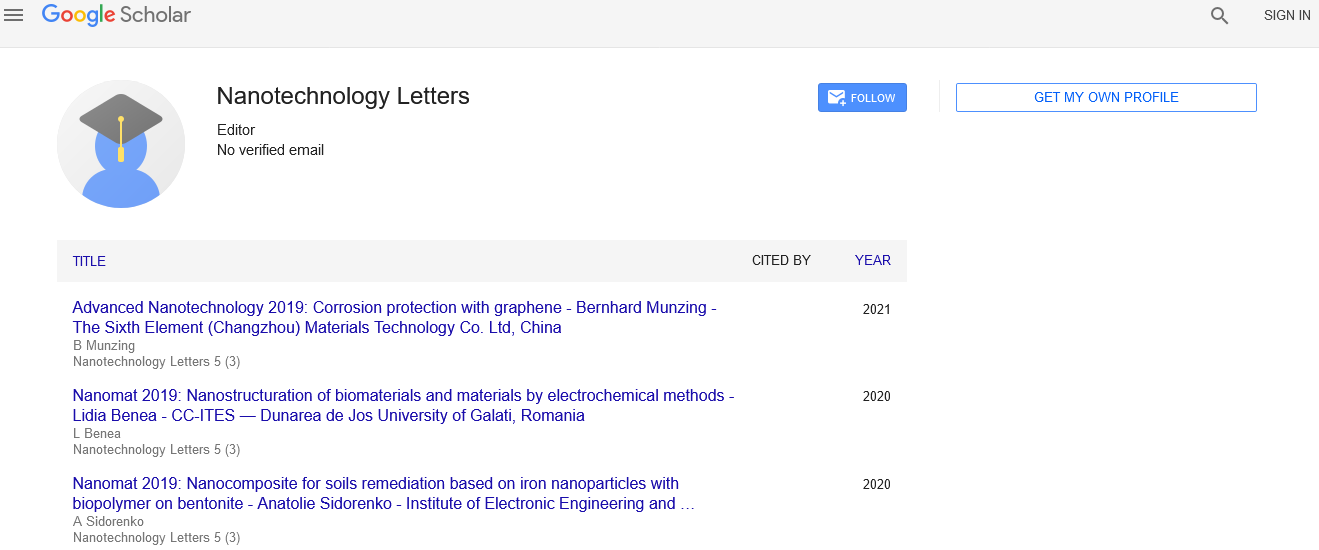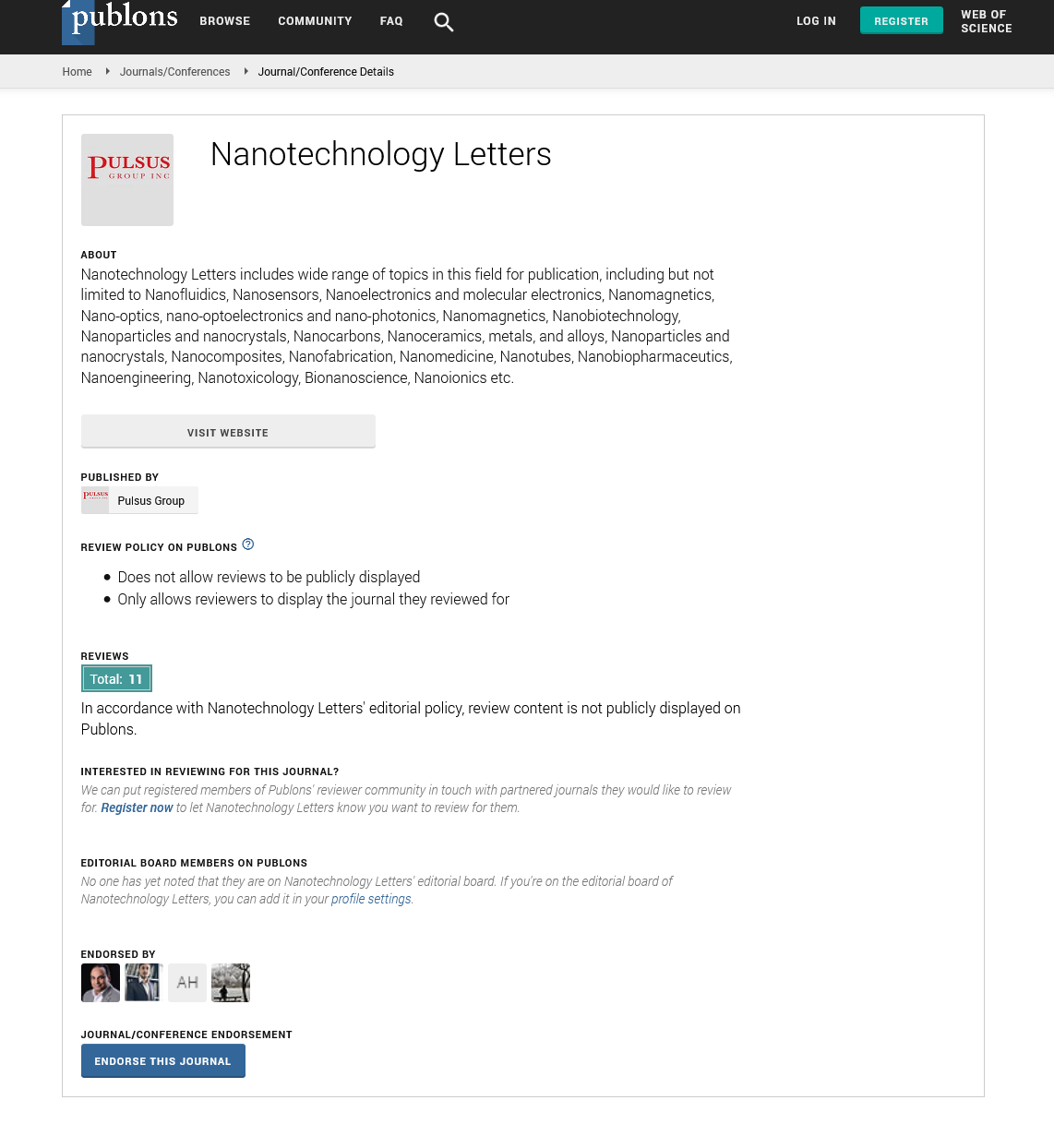Nanomedicine's diagnostic and cellular therapy approaches
Received: 10-Jun-2023, Manuscript No. pulnl-23-6810; Editor assigned: 15-Jun-2023, Pre QC No. pulnl-23-6810 (PQ); Accepted Date: Jun 27, 2023; Reviewed: 18-Jun-2023 QC No. pulnl-23-6810 (Q); Revised: 25-Jun-2023, Manuscript No. pulnl-23-6810 (R); Published: 28-Jun-2023
Citation: Wilson. J. Nanomedicine's diagnostic and cellular therapy approaches. Nanotechnol. lett.; 8(3):44 - 45
This open-access article is distributed under the terms of the Creative Commons Attribution Non-Commercial License (CC BY-NC) (http://creativecommons.org/licenses/by-nc/4.0/), which permits reuse, distribution and reproduction of the article, provided that the original work is properly cited and the reuse is restricted to noncommercial purposes. For commercial reuse, contact reprints@pulsus.com
Abstract
Nanomedicine represents a cutting-edge paradigm in the field of medical science, leveraging nanotechnology to advance the diagnosis and treatment of diseases at the cellular level. This abstract provides a concise overview of key approaches in nanomedicine focusing on diagnosis and cellular therapy. Nanomedicine strategies employ biocompatible nanoparticles and nanoscale materials to enable precise and targeted diagnostic procedures within living organisms. These technologies facilitate early disease detection, monitoring, and provide valuable insights into cellular functions. Furthermore, they pave the way for innovative therapeutic interventions. In the realm of cellular therapy, nanomedicine offers transformative solutions by enabling the delivery of therapeutic agents to specific cells or tissues with unprecedented precision.
Key Words
Nanomedicines; Nanoparticles; Vaccines
Introduction
Nanomedicine, a field of medicine that harnesses the principles and tools of nanotechnology for the prevention and treatment of diseases, was initially inspired by the work of Nobel laureates Metchnikov and Ehrlich in 1908. It focuses on cell-specific diagnostics and therapeutic interventions, utilizing biocompatible nanoparticles and nanoscale materials for activities such as diagnosis, drug delivery, sensing, and manipulation within living organisms. Essentially, nanomedicine involves the application of nanotechnology for medical purposes, employing nanomaterials for disease diagnosis, monitoring, control, prevention, and treatment. Currently, over 400 nanomedicine formulations are undergoing clinical trials, with the expectation of introducing innovative clinical solutions, such as platforms for macromolecule delivery. These innovations may also integrate with other essential technologies, including biotechnologies, advanced materials, biomaterials, and microfluidics. The advantages of nanomedicine are evident in its ability to enhance efficacy, bioavailability, targeting precision, dose-response control, personalization, and safety when compared to traditional medicinal approaches.
Nanomedicine's ultimate aim is to master precise, targeted delivery of intricate assemblies containing multiple therapeutic and diagnostic agents. This enables highly localized drug release without adverse side effects and ensures the reliable detection of site-specific therapeutic responses. In the United States, the National Institute of Health is presently assessing various safety concerns. These include investigating the pathways nanoparticles take within the human body, determining the duration nanoparticles remain in the body,evaluating their impact on cellular and tissue functions, examining how nanoparticles access circulation through dermal exposure, and monitoring unanticipated in vivo reactions.
Doxil was the first cancer nanomedicine to gain approval from the US Food and Drug Administration. Since 1995, it has been employed in the treatment of various adult cancers, including ovarian cancer, multiple myeloma, and Kaposi's sarcoma, a rare cancer that predominantly affects individuals with immune deficiencies such as HIV and AIDS. Doxil, introduced in 1995, is a circulating sustainedrelease liposomal nano formulation of doxorubicin and stands as one of the earliest nanomedicines sanctioned by the FDA.
The future of nanomedicine is a subject of growing interest among scientists who explore its potential in diverse medical applications. These include more efficient drug delivery and targeting, as well as the development of personalized nanomedicine tailored to a patient's genetic profile.
APPLICATIONS OF NANOMEDICINE
1. Drug delivery: Nanoparticles are used to enhance drug delivery by encapsulating drugs, allowing for targeted delivery to specific cells or tissues, reducing side effects, and improving the drug's effectiveness.
2. Cancer treatment: Nanomedicine plays a crucial role in cancer therapy, enabling precise tumor targeting and controlled drug release, which can enhance the efficacy of chemotherapy and reduce harm to healthy cells.
3. Diagnostic imaging: Nanoparticles are employed in various imaging techniques, such as MRI, CT scans, and ultrasound, to improve contrast and provide detailed images for early disease detection.
4. Therapeutic agents: Nanoparticles can be engineered to carry therapeutic agents like RNA or DNA for gene therapy, as well as proteins and antibodies for targeted treatment.
5. Vaccines: Nanoparticles are used in vaccine development to enhance immune response and ensure the stability and controlled release of antigens.
LIMITATIONS OF NANOMEDICINE
1. Bio distribution and toxicity: Nanoparticles used in nanomedicine may distribute in unexpected ways within the body, and their long-term safety and toxicity profiles are not always well-understood. Ensuring that nanoparticles are biocompatible and do not cause harm to healthy tissues is a significant challenge.
2. Regulatory challenges: The regulation of nanomedicine products is complex and varies from one region to another. Developing clear and consistent regulatory guidelines for the approval and marketing of nanomedicine products is an ongoing challenge.
3. Manufacturing and scale-up: Producing nanoparticles at a large scale with consistency can be difficult and costly. The scaling up of nanomedicine manufacturing processes while maintaining product quality and safety is a major challenge.
4. Cost-effectiveness: Developing and producing nanomedicine products can be expensive, which may limit their accessibility to a broader population. Reducing the cost while maintaining effectiveness is a challenge.
5. Resistance and variability: Some diseases, such as cancer, can develop resistance to nanoparticle-based treatments over time. Additionally, the effectiveness of nanomedicine may vary from one patient to another, making personalized medicine challenging.
Conclusion
Nanomedicine has ushered in transformative changes in clinical practice by introducing innovative medications for both diagnosis and treatment. It has addressed previously unmet medical needs by incorporating highly effective molecules that were previously unsuitable due to their elevated toxicity, exemplified by substances like Mepact. Nanomedicine capitalizes on multiple mechanisms of action, as seen with Nanomag, multifunctional gels, optimizing treatment efficacy by enhancing drug availability, reducing dosage, and minimizing toxicity. It offers solutions for drug targeting, controlled and site-specific release, promoting selective distribution within the body, especially in areas with cancerous lesions, and facilitating improved transport through biological barriers.
Nanomedicine encompasses both biological and non-biological medical products. Biological nanomedicines are derived from biological sources, while non-biological variants are referred to as non-biological complex drugs, featuring active components with diverse synthetic structures. Over the past few decades, we have witnessed the translation of numerous nanomedicine applications into clinical practice, ranging from medical devices to nano pharmaceuticals. However, the comprehensive regulation of nanomedicines is an ongoing process, encompassing the establishment of standardized definitions across Europe and the development of protocols for characterizing, evaluating, and controlling the production of nanomedicines. While a universally accepted definition for nanomedicines may prove elusive and possibly impractical, these medical products span a wide spectrum in terms of type and structure, catering to a multitude of applications for acute and chronic diseases.






